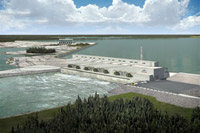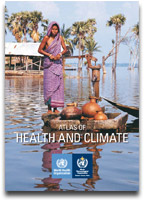
News |
- KI, Ring of Fire, and Resource Sovereignty
- CEAA Invites Comments on Keeyask
- Stop the War on Science: Save the ELA
- Manitoba's New Clean Energy Strategy
- International Climate Talks Begin in Doha, Qatar Begin
- Climate Reports Forecast Dire Climate Future
- IKEA Vows All Solar and Wind Power
- China Deal Assaulting Canadian Environment and Democracy
- CEC Bipole III Hearings Adjourned Until March 2013
- Environment Hearings & Economic Review for Dams Announced
- BP Settlement and Criminal Charges
- Atlas of Health and Climate Released by WHO
| KI, Ring of Fire, and Resource Sovereignty | 30 November 12 |

The traditional area KI is located in is called the "Ring of Fire" by exploration companies. Discovery of extensive chromite deposits along with nickel and copper near McFaulds Lake and the Attawapiskat River have raised the possibility of large and long-term developments in a remote area on the fringe of the Hudson Bay Lowlands. In July 2011, KI held a community referendum and, passed into law a declaration that in effect "nationalized" all the resources on their homelands and protected all the waters flowing in and out of Big Trout Lake watershed, in the core of their homeland. This is a Canadian first. With exploration and mining companies expecting substantial subsidies from the Ontario government, taxpayers will potentially be on the hook for millions of dollars. No proper assessment of infrastructure needs and environmental impact assessments have been done to date. The costs for clean up after the mining companies have left are unknown. View No Means No: The Kitchenuhmaykoosib Inninuwug and the Fight for Resource SovereigntyView November 26, 2012 MiningWatch Canada article View September 27, 2012 The Star article View June 27, 2012 The Star article View National Post article |
|
 Print version Print version |
Top |
| CEAA Invites Comments on Keeyask | 30 November 12 |

Following this comment period, CEAA will prepare the Comprehensive Study Report, setting out its conclusions on the environmental effects, the proposed mitigation measures and the significance of any remaining adverse environmental effects. A public comment period on the Comprehensive Study Report will be announced at a later date. The proposed Keeyask Generation Project, is a $5.6 billion 695-megawatt hydroelectric dam, slated for development by Keeyask Hydro Power Limited Partnership (between Manitoba Hydro and four nearby Manitoba First Nations) on the Nelson River at Gull Rapids near Gillam, Manitoba. Modern dams in Manitoba require at least three licenses. Two licenses from the Manitoba government: a Water Power Act license, and an Environment Act License; plus a federal permit under the Canadian Environmental Assessment Act (CEAA). The federal environmental assessment also considers a proposal by Manitoba Hydro for a 22 kilometre transmission line to provide construction power to the Keeyask Generation Project and three 35 kilometre long transmission lines within a single corridor to transmit electricity from the Keeyask Generation Project to the existing Radisson Converter Station near Gillam, Manitoba. Unlike CEAA, the Manitoba Government Environmental Approvals Branch is attempting to license the Keeyask Infrastructure, Keeyask Generation, and Keeyask Transmission projects separately. View November 21, 2012 Canadian Environmental Assessment Agency (CEAA) Public NoticeView Canadian Environmental Assessment Agency (CEAA), Keeyask Generating Station Reference Number 11-03-64144 View Keeyask Hydro Power Limited Partnership website View Manitoba Wildlands Manitoba Hyrdo Projects page Source:
Canadian Environmental Assessment Agency
|
|
 Print version Print version |
Top |
| Stop the War on Science: Save the ELA | 30 November 12 |

"Cutting the ELA – the only research center capable of providing a solid science basis for freshwater policy – is extremely short-sighted," insists award-winning, world-renowned freshwater expert Dr. David Schindler, Killam Memorial Chair in Ecology, University of Alberta. "The Harper government is gutting all and any tools, rules, and science projects that stand in the way of corporate abuse of our freshwater heritage," says Maude Barlow, National Chairperson of the Council of Canadians. "No ELA means that the damage done to water from extractive industries will forever be hidden." "This is the only place in the world where lakes have been set aside to build a research base to save our planet's threatened freshwater – and so we must save ELA," concludes Dr. Jon Gerrard, Leader of the Manitoba Liberal Party. "We need to stop this war on science, and let's start by saving the ELA," asserts Diane Orihel, Director of the Coalition to Save ELA. Watch November 27, 2012 Save The ELA videoVisit Save ELA website View Save the ELA Facebook page View Save the ELA Twitter page View November 9, 2012 Metro article View October 18, 2012 CBC News article |
|
 Print version Print version |
Top |
| Manitoba's New Clean Energy Strategy | 30 November 12 |

"This strategy is all about making energy choices today that will create a stronger economy and a cleaner environment for our future. Is fossil fuel freedom achievable? We're closer than you might think," stated Chomiak. Priorities the Manitoba Government identified in the strategy include:
"We certainly do need to wean ourselves from dependence on fossil fuels. There are both good and not so good aspects to this strategy, but with public input it could have been significantly improved. It is unfortunate this strategy was released without any opportunities for public input," said Manitoba Wildlands Director Gaile Whelan Enns. View November 20, 2012 Government of Manitoba What Matters Most: Manitoba's Clean Energy Strategy (PDF)View November 20, 2012 Government of Manitoba press release View November 22, 2012 Portage Daily Graphic coverage View Manitoba Wildlands Governments page Source:
Government of Manitoba
|
|
 Print version Print version |
Top |
| International Climate Talks Begin in Doha, Qatar Begin | 23 November 12 |

Doha 2012, this year's annual United Nations Climate Change Conference, will be held Monday, November 26th to Friday, December 7th 2012 at the Qatar National Convention Centre in Doha, Qatar. The central goal of Doha 2012 is to build upon the so-called "Durban Platform" agreed to at the end of UNFCCC conference in Durban, South Africa (Durban 2011). In Durban Governments agreed to establish a new legally binding agreement structure by 2015. A new binding agreement is not expected to be concluded at Doha 2012, but it is hoped discussions will help establish the framework for an agreement. The European Union (EU), Australia, Norway, Switzerland and a handful of other countries are expected to sign up for a second commitment period under the Kyoto Protocol (a sub-agreement of the UNFCCC signed at the 1997 annual conference in Kyoto, Japan that set binding obligations on industrialized countries to reduce their emissions of GHGs). But earlier Kyoto Protocol signatories such as Canada, Russia, and Japan are refusing to sign-on for a second commitment period. Manitoba Wildlands will be providing selected and recommended links for news, reports, and analysis regarding the Doha 2012 UN Climate Summit: November-December 2012. Visit our page content for more information. View Manitoba Wildlands, COP 18 - Doha 2012 pageView Official Doha 2012 - COP 18 page View UNFCCC Doha 2012 - COP 18 page View Climate Action Network International (CANET) Sources:
Manitoba Wildlands
|
|
 Print version Print version |
Top |
| Climate Reports Forecast Dire Climate Future | 23 November 12 |

As global warming approaches and exceeds 2-degrees Celsius, there is a risk of triggering nonlinear tipping elements. Examples include the disintegration of the West Antarctic ice sheet leading to more rapid sea-level rise, or large-scale Amazon dieback drastically affecting ecosystems, rivers, agriculture, energy production, and livelihoods. Atmospheric levels of carbon dioxide are at an all-time high and are projected to continue booming. Many scientists feel global warming of 2 degrees or greater is inevitable. Internationally renowned business firm Pricewaterhouse Coopers, issued a report, titled "Too Late for Two Degrees?." The report suggested that current efforts to reduce the carbon intensity, or the amount of emissions per unit of GDP, are unfolding so slowly as to be negligible. The Paris-based International Energy Agency (IEA), suggested in its annual World Energy Outlook that even accounting for the policy commitments already made or contemplated by world governments, energy-related emissions are expected to continue to rise over the next two decades, pointing to a "long‐term average temperature increase of 3.6 degrees Celsius. A World Bank report entitled, "Turn Down the Heat: Why a 4°c Warmer World Must Be Avoided", suggests that the climate could warm a full 4 degrees by the end of the century even if countries fulfill the modest emissions-reduction pledges they've already made. "Lack of action on climate change threatens to make the world our children inherit a completely different world than we are living in today," said World Bank Group President Jim Yong Kim. "It is still possible to avoid 2-degree warming, and arguing it is too late could very easily be a self-fulfilling prophecy," said Michael E. Mann, a climatologist and director of the Earth System Science Center at Pennsylvania State University. "That having been said, the real issue is whether or not we have the political will." "It would take an incredible effort, but that's what we're trying to spur," said author and activist from 350.org Bill McKibben, "Given the damage that 1 degree is doing, we're already at 'dire,'" McKibben said. "We dearly don't want to see what 2 degrees looks like, much less 3." View November 21, 2012 Huffington Post coverageView November 18, 2012 World Bank report View November 12, 2012 International Energy Agency (IEA) report View November 1, 2012 Pricewaterhouse Coopers report Sources:
Huffington Post
|
|
 Print version Print version |
Top |
| IKEA Vows All Solar and Wind Power | 23 November 12 |

IKEA already owns wind farms in six European nations and has 342,000 solar panels on its stores, warehouses and factories that generate 27% of the company's electricity. IKEA hopes to increase this to 70% by 2015, and 100% by 2020. "We know we're going to be using energy in 20 years' time," said IKEA Chief Sustainability Officer Steve Howard. "If we can own our own renewable energy plants ... it gives us complete price certainty." The initiative is part of IKEA's People & Planet Positive strategy, which aims to satisfy consumer demand for more sustainable products, while also saving money for both IKEA and its clients. The People & Planet Positive strategy also calls for IKEA, one of the world's top users of wood, to grow at least as many trees as it uses to make products such as beds or cupboards by 2020. Already, IKEA says it does not take wood from natural tropical forests, such as in the Amazon or the Congo basins. "With the opening of IKEA in Winnipeg we can look forward to IKEA wind turbines in Manitoba too," said Gaile Whelan-Enns Director of Manitoba Wildlands. John Sauven, head of Greenpeace UK, said the People & Planet Positive strategy "puts IKEA at the forefront of leading companies" trying to transform their businesses in the face of environmental threats. View October 23, 2012 IKEA press releaseView October 25, 2012 Global Fund Exchange, Future of Energy blog View October 24, 2012 National Geograhic, Great Energy Challenge blog View October 23, 2012 Reuters coverage View October 23, 2012 USA Today coverage Sources:
IKEA, Reuters
|
|
 Print version Print version |
Top |
| China Deal Assaulting Canadian Environment and Democracy | 23 November 12 |

As a result, this trade deal allows companies from China to ignore Canada's environmental laws and regulations in pursuit of profits from natural resource extraction. The FIPA with China is, one sided in China's favour. The agreement Article 4 allows China to bypass and contest provincial, territorial, First Nations, municipal or successive federal government decisions on resource and commercial management. If the National Energy Board approves the Northern Gateway Pipeline through B.C., but B.C. restricts or rejects the deal, Sinopec can sue under this treaty. The matter would then be resolved behind closed doors in arbitration by two lawyers from outside Canada. FIPAs are treaties between two nations that impose binding obligations on both countries with respect to their treatment of foreign investors and investment. They generally provide guarantees pertaining to non-discriminatory treatment, expropriation, transfer of funds, transparency, due process and dispute settlement. Matthew Carroll, the campaign director for Leadnow.ca, said the secrecy in the process is just part of the concern. The Canada-China FIPA agreement allows the partner governments to keep lawsuits and settlements private — which is not the case with the North American Free Trade Agreement. "If a Canadian government is sued under NAFTA, that becomes public information. But it's entirely up to the discretion of our government whether or not they make the information under this FIPA public," he said. View November 2, 2012 Financial Post articleView October 31, 2012 Ottawa Citizen article View October 31, 2012 Ottawa Citizen article View October 30, 2012 Huffington Post article View October 26, 2012 De Smog Blog post View October 22, 2012 The Province article View October 17, 2012 Huffington Post article View Stephen Harper's Assault on Democracy View January 11, 2010 National Union of Public and General Employees article |
|
 Print version Print version |
Top |
| CEC Bipole III Hearings Adjourned Until March 2013 | 16 November 12 |

During week five of the CEC hearings Manitoba Hydro revealed it was making three changes in the route for the Bipole III corridor. A presentation about the route changes was made during the hearing, and is recorded in the transcript. Questions regarding environmental statements (EIS), full information, additional requirements on participants, review of these route changes by the public and hearing participants went into the record. Letters on November 2 and November 9 addressed to Manitoba Hydro from the director of licensing for the Environment Act clarified that EIS materials will be filed under the Environment Act, and undergo the usual reviews. Manitoba Hydro has to file the EIS to support these route changes by January 28, 2013. The chair of the CEC, Mr. T Sargent, has indicated that hearings will resume in early March, 2013. Due to the adjournment on November 22, 2012, closing statements from participants are held over until hearings resume in March 2013. |
|
 Print version Print version |
Top |
| Environment Hearings & Economic Review for Dams Announced | 16 November 12 |

Minister Gord MacKintosh referred the Keeyask Generation Station and transmission system to the Clean Environment Commission (CEC) for review and public hearings. The minister acknowledges that the Canadian Environment Assessment Agency will undertake an assessment of the project. Public comments on the Environment Impact Statement (EIS) for the Keeyask dam and its transmission are due December 21, 2012. A technical advisory committee (TAC) made up of both federal and provincial agencies also reviews the EIS and provides technical review comments. All correspondence, the EIS, TAC and public review comments are part of the public registry file under the Environment Act. The terms of reference for the CEC hearings were also released, and are available on the conservation department webpage. The CEC will post information, set schedules, seek participants for the hearings in the near future. The hearings will occur in affected communities and in Winnipeg. Participant funding will be available. A second announcement by Minister MacKintosh directs the Public Utility Board to conduct a 'Needs for and Alternatives To' review of: Keeyask and Conawapa generation stations, and associated transmission facilities. No mention of export sale agreements, or the transmission line required for recent export sales to Wisconsin appears in the press release. A Public Utilities Board sub panel will conduct the review. Terms of reference will be public in early 2013. View November 14, 2012 Minister of Conservation and Water Stewardship letter to CECView November 16, 2012 Government of Manitoba news release View November 16, 2012 Government of Manitoba news release |
|
 Print version Print version |
Top |
| BP Settlement and Criminal Charges | 16 November 12 |

BP is to pay $4.5 billion dollars in fines over the next five years as well as being made to report to an operations monitor for the next four years, and update all its safety equipment and procedures on all its oil rigs. The fine handed to BP is the largest in American history. Three former BP employees have been charged with separate felony counts. Donald Vidrine and Robert Kaluza, BP drilling managers overseeing operations on Deepwater Horizon, were charged with 22 counts of negligent manslaughter for the deaths of the 11 rig workers. Former BP vice president in charge of exploration in the Gulf of Mexico, David Rainey, was charged with felony obstruction of justice for allegedly lying to Congress and federal law enforcement officials about the amount of oil leaking from the well. View November 15, 2012 Attorney General Eric Holder speech at the BP Press ConferenceView November 15, 2012 Huffington Post article View November 15, 2012 British Petroleum press release View November 15, 2012 CBC News article View November 19, 2012 PlanetArk article |
|
 Print version Print version |
Top |
| Atlas of Health and Climate Released by WHO | 16 November 12 |

At 68 pages, the Atlas gives practical examples of how weather and climate information can protect public health in the face of climate variability and extreme weather events. Links between health and climate are shown in maps, tables, graphics. "Stronger cooperation between the meterological and health communities is essential to ensure that up to date, accurate and relevant information on weather and climate is integrated into public health management at international, national and local levels." said WMO Secretary General Mr. Michel Jarraud. View 2012 WHO/WMO report Atlas of health and climate |
|
 Print version Print version |
Top |


 RSS Feeds:
RSS Feeds: